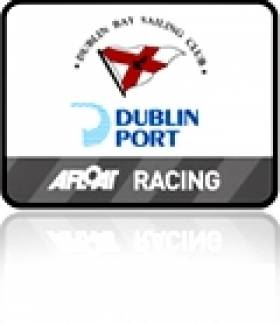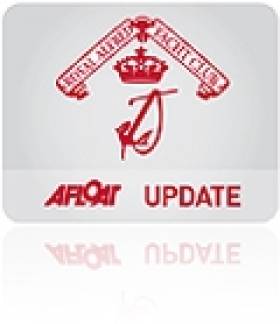Displaying items by tag: Flying fifteen
Keith Poole's 'The Gruffalo' made the most of the fact that several of the top Flying Fifteens were sailing the Northern Championships on the Ards Peninsula this weekend when he took a first and second in today's Dublin Bay Sailing Club races. Frank Burgess in Snow White Beat Grufalo in Race one but Poole struck bac k later in the afternoon to win from Tom Leonard's Mellifluence in the second race. Full results for June 12th Dublin Bay Sailing Club Results below:
DUBLIN PORT Dublin Bay Sailing Club Results for 12 JUNE 2010
BENETEAU 31.7 - ECHO 1. Legally Blonde (C.Drohan/P.Egan), 2. Thirty Something (Gerry Jones et al), 3. Flying Machine (Conor O'Gallagher)
BENETEAU 31.7 - 1. Legally Blonde (C.Drohan/P.Egan), 2. Thirty Something (Gerry Jones et al), 3. Flying Machine (Conor O'Gallagher)
CRUISERS 0 - ECHO 1. Lively Lady (Derek Martin), 2. Tsunami (Vincent Farrell), 3. WOW (George Sisk)
CRUISERS 0 - 1. Lively Lady (Derek Martin), 2. WOW (George Sisk), 3. Tsunami (Vincent Farrell)
CRUISERS 1 - 1. Jalapeno (Dermod Baker et al), 2. Powder Monkey (C.Moore/M.Byrne), 3. Xtravagance (Colin Byrne)
CRUISERS 1 - 1. Powder Monkey (C.Moore/M.Byrne), 2. Jetstream (Peter Redden), 3. Jalapeno (Dermod Baker et al)
CRUISERS 2 - 1. Jawesome 11 (V.Kennedy/M.Dyke), 2. Dick Dastardly (B.Cusack et al), 3. Red Rhum (J Nicholson)
CRUISERS 2 - ECHO 1. Kamikaze (P.Nash/B.McIntyre), 2. Red Rhum (J Nicholson), 3. Jawesome 11 (V.Kennedy/M.Dyke)
CRUISERS 3 - ECHO 1. Papytoo (M.Walsh/F.Guilfoyle), 2. Carrabeg (D.Martin/R.Deasy), 3. Pamafe (Michael Costello)
CRUISERS 3 - 1. Two Step (Ross Doyle), 2. Asterix (J.Counihan/F.Meredith), 3. Papytoo (M.Walsh/F.Guilfoyle)
CRUISERS 4 - 1. Rascal (K.Burke/S.Milner), 2. Ghrazel (Charles Pearson), 3. Maranda (Myles Kelly)
DRAGON - 1. Diva (R.Johnson/R.Goodbody), 2. Zinzan (Daniel O'Connor et al), 3. Zu (P.Dee et al)
DRAGON – Race 2 1. Zu (P.Dee et al), 2. Diva (R.Johnson/R.Goodbody), 3. Zinzan (Daniel O'Connor et al)
FIREBALL - 1. Goodness Gracious (Louise McKenna), 2. Incubus (S Oram)
FLYING FIFTEEN - 1. Snow White (Frank Burgess), 2. The Gruffalo (Keith Poole), 3. Gekko (S & P Nolan)
FLYING FIFTEEN - 1. The Gruffalo (Keith Poole), 2. Mellifluence (Tom Leonard), 3. Snow White (Frank Burgess)
GLEN - 1. Glendun (B.Denham et al), 2. Glenshesk (L.Faulkner et al), 3. Glenluce (D & R O'Connor)
IDRA 14 FOOT - 1. Dunmoanin (Frank Hamilton), 2. Sapphire (Lorcan O'Sullivan)
IDRA 14 FOOT - 1. Sapphire (Lorcan O'Sullivan), 2. Dunmoanin (Frank Hamilton)
MERMAID - 1. Lively Lady (G O'Neill & M Hanney), 2. Jill (P.Smith/P.Mangan)
MERMAID - 1. Lively Lady (G O'Neill & M Hanney), 2. Jill (P.Smith/P.Mangan), 3. Tijuana (David Creedon)
SHIPMAN - 1. Kelema (N.Blake/Z.Grace), 2. Euphanzel lll (Louis McSherry et al), 3. Ruadh (J.O'Connor/J.O'Callaghan)
SQUIB - 1. Buzz Lite (G.O'Connor/B.Foster), 2. Lola (Frank Whelan), 3. Anemos (Pete & Ann Evans)
SQUIB - 1. Lola (Frank Whelan), 2. Ladybird (M.Muldoon/B.Stevens), 3. Anemos (Pete & Ann Evans)
WHITE SAIL CRUISERS - ECHO 1. Finnegans Wake (T.Rowlands et al), 2. Afternoon Delight (Michael Bennett et al), 3. The Great Escape (P & D Rigney)
WHITE SAIL CRUISERS - 1. Windshift (R O'Flynn et al), 2. Act Two (Michael O'Leary et al), 3. The Great Escape (P & D Rigney)
There was a familiar ring to this evening's Royal Alfred prizegiving roll call where Baily Bowl trophies were presented to top ranked sailors in four separate classes.
A weekend of one design class action produced a testing five race series. Light to medium north-westerlies prevailed with some big shifts coming off the Dublin bay shoreline making for plenty of place changes both upwind and downwind on well laid, windward-leeward courses.
The competition was hosted by the National YC due to marina replacement works at the Royal St. George YC.
SB3's and Dragons raced on one course in the middle of the bay while the Flying 15's and Squibs race in Seapoint Bay, so close to the Sandymount shore on Saturday that the weather mark was laid in only nine foot of water.
The event - were it required - confirmed that the SB3 is the most popular one design in the country, the class producing a fine fleet of 22 boats almost twice the size of the other three fleets.
Allthough Howth's Ben Duncan, sailing Sharkbait, continues his domination of the class it was good to see Bray Sailing Club''s Marty Cuppage in third overall, one place behind Belfast Lough's David Cheyne.
Local favourite Sean Craig sealed his fate on Saturday when he counted a premature start penalty (OCS) in the afternoon race but neverthless a final race win today moved him to sixth overall.
If the SB3 is the most popular class then it has most likely been at the cost of the Dublin Bay Dragon fleet where weekend numbers did not make double figures. Rick Johnson sailing Diva continued his recent Dublin Bay form beating Andrew Craig's Chimaera who finished second and Peter Bowring's Phantom in third.
The National Yacht Club's John Lavery was the clear winner (three race wins) of the Flying fifteens where a dozen boats sailed. It was Northern Ireland travellers Andy Martin in second and Brian McKee third in a fleet otherwise made up from the local Dublin Bay class. It was disappointing turnout in some respects because the local fleet numbers almost 30 boats and the Baily Bowl doubled as a class championship.
In preparation for next month's British and Irish Squib Championships at the same venue the Royal St. George's Vincent Delany took a well earned win with three race wins in his final tally. Peter Wallace sailing Toys for the Boys was second and Lola (Frank Whelan) was third.
Irish Sailing Classes and Associations
Spoiled for Choice
There’s no shortage of one-design classes from which to choose and each gives its enthusiasts great competition, fun and camaraderie, writes Graham Smith in this review of the classes. A profile of each active class in Ireland is supplied below; just click on the title link (in bold) or the Class Association link to go directly to the information.
One-design racing is where it all starts. It is, after all, where all the top sailors earned their stripes, battling away for line honours without a thought for a handicapper’s calculator wiping away a hard-fought victory!
Indeed, you could count on less than one hand the number of top Irish sailors who didn’t cut their teeth in a one-design dinghy! Just think of Cudmore, Barrington, Watson, Wilkins, Hennessy and Dix to name a few and you realise that they honed their skills in everything from Enterprises to Lasers and a lot in between.
At present count, there are a little over 30 one-design classes in Ireland, split almost evenly between dinghies and keelboats, a statistic which might raise a few eyebrows. They range from the long-established Mermaids, IDRA14s and Dragons to the newer additions like Fevas, Topaz and RS Elite. They all fill a particular need and give their owners and crews considerable enjoyment.
Many have attracted their World or European Championships to Irish waters over the years and while 2009 is notable for a lack of such events here, the following year will see the Etchells Worlds at Howth and perhaps a few other international regattas too.
In addition to the review, we asked each class to complete a questionnaire giving details of their fleet numbers, whether they were on a growth pattern or holding their own, so we could highlight those ‘on the up’ and those remaining static in terms of numbers. The older traditional designs, as you might imagine, fall into the latter category, although that’s not a negative!
CLASS REVIEW The State of the Classes – League Table (as at February 2009)
S = Static; U = Up/growing
275 Optimist U
200+ Laser S
189 Mermaid S
160 Flying Fifteen S
130 RS Feva U
115 Shannon One Design U
100+ Mirror S
100+ Topper U
99 Topaz U
94 Laser SB3 U
87 GP14 U
85 Squib S
70 Fireball S
70 Ruffian S
60 J24 S
60 Shipman S
52 Dragon S
50 RS400/200 S
50 420 U
43 Multihulls U
42 Dragon S
40 Water Wags U
40 Wayfarer S
34 IDRA14 U
33 Puppeteer U
28 Etchells S
27 E-Boat U
26 Glen S
25 Enterprise S
18 Sigma 33 S
18 Howth 17 U
13 RS Elite U






























































